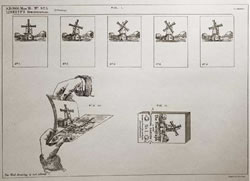FLIP BOOKS
A flip book or flick book is a book with a series of pictures that vary gradually from one page to the next, so that when the pages are turned rapidly, the pictures appear to animate by simulating motion or some other change. Flip books are often illustrated books for children, but may also be geared towards adults and employ a series of photographs rather than drawings. Flip books are not always separate books, but may appear as an added feature in ordinary books or magazines, often in the page corners. Software packages and websites are also available that convert digital video files into custom-made flip books. Is recognised as one of the earliest forms of interactive multimedia interms of pre cinema and the origins of animation. There are naturally many claims as to who invented the technique though can only be pinned down to a certain degree to each countries history of the technique. E.g The first American patents were attributed to Henry Van Hoevenbergh on 16th June 1882
Heres a cool example I found on youtube that someone did as a project
Zoescopes
Invented by Eadward James Muybridge (April 9, 1830 - May 8 1904), who was an English photographer. Known for his experiments with multi camera set ups to capture motion, he used the Zoescope (established by William George Horner) to run his photos together in order for people to get a good visualization of motion that their naked eye would not ordinarily see. His experiments is believed to have laid down the path for the techniques we use today in order to make films. Moved to San Francisco in 1865 where he furthered his career in photography, mostly landscapes. It was in 1872 when Muybridge was commissioned using the latest photographic technology to establish whether or not at one point a galloping horse had all four feet off the ground. Here is a short example of a zoescope http://vimeo.com/19605257 Another item to show movement was the zoopraxiscope, also known as the phenakistiscope. Similar to that of the zoescope, instead of a rotating cylinder shape it is simply a spinning disc that gives the false illusion of motion.
Praxinoscope
Developed in 1877 by a French professor of natural sciences named Emile Reynaud. This device was a some what updated version of Horner's Zoescope. The Zoescope has sight slits and dark phases in between the images to where the viewer looks to the inner wall of the outer frame to see the run of images. With the Praxinoscope, the images are again placed on the inner wall of the outer circumference but instead mirrors are placed in a circle format within the rotating drum.The transition from one image to the next hardly noticeable, because the second image merges along side into the first before replacing it completely.
Mutoscopes
The Mutoscope was an early motion picture device
thaumatrope





No comments:
Post a Comment